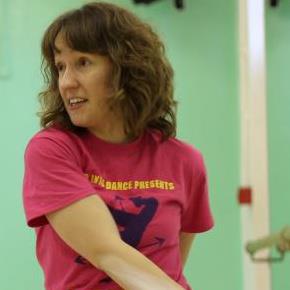 Gemma Coldicott, Step into Dance’s Inclusive Dance Development Officer, has a wealth of dance experience. From studying Dance in the Community at Laban to gaining a Masters in Inclusive Arts Practice from the University of Brighton, Gemma is a leader in her field. Since her studies Gemma now works to mentor and support freelancers teaching inclusive dance sessions, leads inclusive dance training courses, writes training resources and is currently the company Director of SLiDE (South London Inclusive Dance Experience).
Gemma Coldicott, Step into Dance’s Inclusive Dance Development Officer, has a wealth of dance experience. From studying Dance in the Community at Laban to gaining a Masters in Inclusive Arts Practice from the University of Brighton, Gemma is a leader in her field. Since her studies Gemma now works to mentor and support freelancers teaching inclusive dance sessions, leads inclusive dance training courses, writes training resources and is currently the company Director of SLiDE (South London Inclusive Dance Experience).
When did you begin dancing, where and why?
I started dancing aged 3 in my hometown of Norwich. My mum took me to the local ballet school, I guessed I asked to go but maybe she dragged me along. But I’m so glad she did!
What were your early years of dancing and training like?
I did 15 years of ISTD Ballet, Tap and Modern, until I was 18.
What does dance mean for you?
Dance means expression and freedom. It has the power to change lives and to bring diverse groups of people together.
How long have you been working as an inclusive dance practitioner? How did it begin?
Ever since I left Laban in 2007! Shortly after I finished training I participated in a project with Heart n Soul, a learning disabled arts organisation based in Deptford. It was a dance project with 60 people, disabled/non disabled, and culminated in a performance on the steps outside the National Portrait Gallery in Trafalgar Square. It was an amazing experience and I understood from then on what I wanted to do, to give people access to dance who might not ordinarily get the chance.
What is a ‘typical’ day like?
Answer emails from 8am and post on social media. 10am, visit a dance class at an SEN school on the Step into Dance School somewhere in London, give the teacher feedback and support. Head back to the RAD office and complete emails, observation reports. I then attend or teach a community dance class.
What’s the best part of dance for you?
That it brings a smile to people’s faces who are both dancing and watching! It’s also the relationship between music and dance, it connects the mind, body and soul.
What would you say was your greatest dance achievement to date?
That 80 people attended my inclusive dance training days at the RAD last year, from all across the country. To share my skills and knowledge in this way feels great.
What advice would you give to someone aspiring to be part of the dance industry?
Do as much assisting, shadowing as you can with teachers and practitioners you respect. Be professional at all times, always be on time and be reliable. Attend courses and workshops at venues such as gDA for professional development; you never know who you are going to meet at these things. The key word is networking!
What’s next for you?
At the moment I am working hard at Step into Dance to get SEN and mainstream schools dancing together. I am hosting afternoons of dance called ‘Step togethers’ whereby disabled and nondisabled students dance together and perform for each other. Our aim on the Step into Dance programme is to promote inclusion and equality for young people across London and I think we are really achieving this.
Which classes are you holding at MOVE IT?
At MOVE IT I am running a workshop called ‘Introduction to Inclusive Dance Practice’. I shall be focusing on facilitation skills and running creative tasks with mixed ability groups. I hope to give everyone more confidence in leading creative dance sessions and some key ‘tools’ to take back and apply in their own settings.
